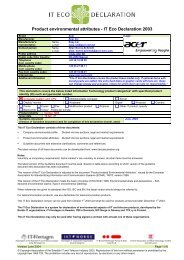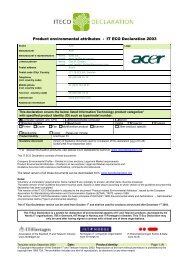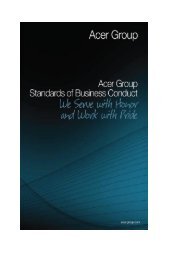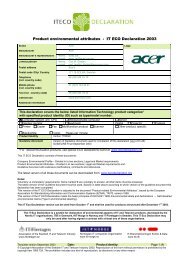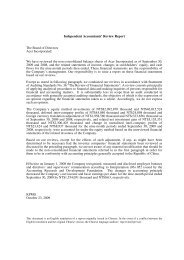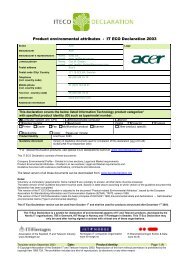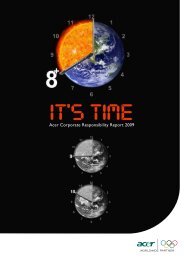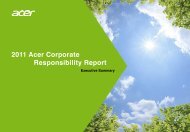Consolidated Financial Statements - Acer Group
Consolidated Financial Statements - Acer Group
Consolidated Financial Statements - Acer Group
Create successful ePaper yourself
Turn your PDF publications into a flip-book with our unique Google optimized e-Paper software.
53ACER INCORPORATED AND SUBSIDIARIESNotes to <strong>Consolidated</strong> <strong>Financial</strong> <strong>Statements</strong> (continued)(ii) Credit riskThe <strong>Consolidated</strong> Companies‟ credit risk is mainly from potential breach of contract by thecounter-party associated with cash, equity investment, and derivative transactions. In order tocontrol its exposure to the credit risk of each financial institution, the <strong>Consolidated</strong> Companiesmaintain cash with various financial institutions and hold equity investments in the form ofstocks issued by companies with high credit quality. As a result, the concentration of creditrisks related to cash and equity investments is not significant. Furthermore, the banksundertaking the derivative transactions are reputable financial institutions; therefore, theexposure related to the potential default by those counter-parties is not considered significant.The <strong>Consolidated</strong> Companies primarily sell and market the multi-branded IT products throughdistributors in different geographic areas. Also, management of the <strong>Consolidated</strong> Companiescontinuously evaluates the credit quality of their customers in order to minimize credit risk. Asa result, management believes that there is no significant concentration of credit risk.(iii) Liquidity riskThe <strong>Consolidated</strong> Companies‟ capital and operating funds are sufficient to fulfill their contractpayment obligations. Therefore, management believes that there is no significant liquidityrisk.The available-for-sale financial assets held by the <strong>Consolidated</strong> Companies are equity securitieswhich are publicly traded and can be liquidated quickly at a price close to the fair market value.In contrast, the financial assets carried at cost are not publicly traded and are exposed toliquidity risk.Derivative financial instruments are intended to hedge the exchange rate risk resulting fromassets and liabilities denominated in foreign currency and cash flows resulting from anticipatedtransactions in foreign currency. The length of the contracts is in line with the payment dateof the <strong>Consolidated</strong> Companies‟ assets and liabilities denominated in foreign currency and theanticipated cash flows. At the maturity date of the derivative contract, the <strong>Consolidated</strong>Companies will settle these contracts using the foreign currencies arising from the hedgedassets and liabilities denominated in foreign currency, and therefore, the liquidity risk is notsignificant.(iv) Cash flow risk related to the fluctuation of interest ratesThe <strong>Consolidated</strong> Companies‟ short-term borrowings and long-term debt carried floatinginterest rates. As a result, the effective rate changes along with the fluctuation of the marketinterest rates and thereby influences the <strong>Consolidated</strong> Companies‟ future cash flow. If themarket interest rate increases by 1%, cash outflows in respect of these interest payments wouldincrease by approximately NT$94,812 per annum.(Continued)



